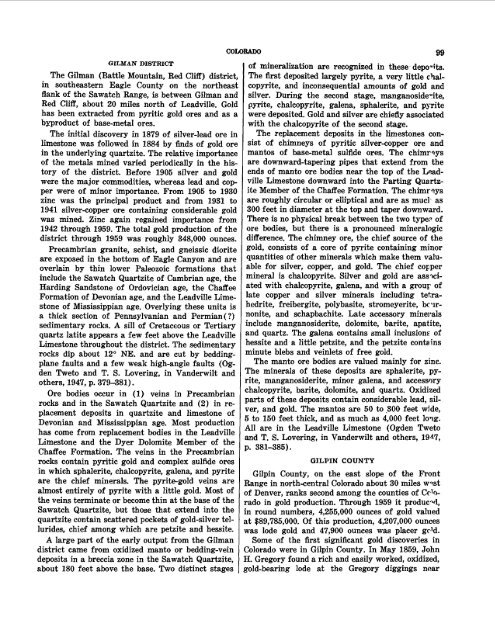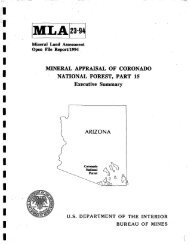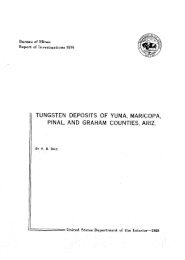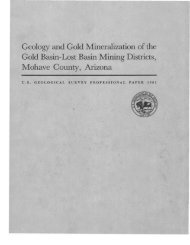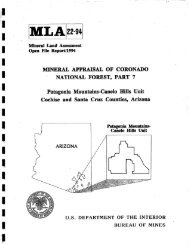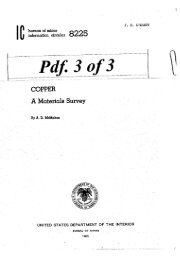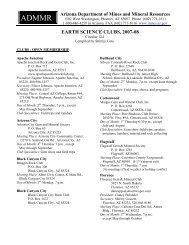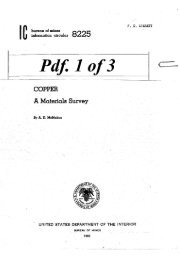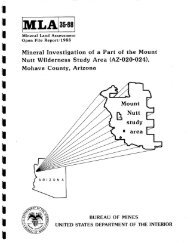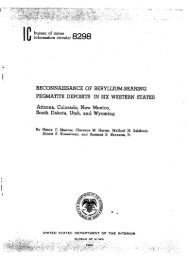here - State of Arizona Department of Mines and Mineral Resources
here - State of Arizona Department of Mines and Mineral Resources
here - State of Arizona Department of Mines and Mineral Resources
You also want an ePaper? Increase the reach of your titles
YUMPU automatically turns print PDFs into web optimized ePapers that Google loves.
GILMAN DISTRICT<br />
The Gilman (Battle Mountain, Red Cliff) district,<br />
in southeastern Eagle County on the northeast<br />
flank <strong>of</strong> the Sawatch Range, is between Gilman <strong>and</strong><br />
Red Cliff, about 20 miles north <strong>of</strong> Leadville. Gold<br />
has been extracted from pyritic gold ores <strong>and</strong> as a<br />
byproduct <strong>of</strong> base-metal ores.<br />
The initial discovery in 1879 <strong>of</strong> silver-lead ore in<br />
limestone was followed in 1884 by finds <strong>of</strong> gold ore<br />
in the underlying quartzite. The relative importance<br />
<strong>of</strong> the metals mined varied periodically in the history<br />
<strong>of</strong> the district. Before 1905 silver <strong>and</strong> gold<br />
were the major commodities, w<strong>here</strong>as lead <strong>and</strong> copper<br />
were <strong>of</strong> minor importance. From 1905 to 1930<br />
zinc was the principal product <strong>and</strong> from 1931 to<br />
1941 silver-copper ore containing considerable gold<br />
was mined. Zinc again regained importance from<br />
1942 through 1959. The total gold production <strong>of</strong> the<br />
district through 1959 was roughly 348,000 ounces.<br />
Precambrian granite, schist, <strong>and</strong> gneissic diorite<br />
are exposed in the bottom <strong>of</strong> Eagle Canyon <strong>and</strong> are<br />
overlain by thin lower Paleozoic formations that<br />
include the Sawatch Quartzite <strong>of</strong> Cambrian age, the<br />
Harding S<strong>and</strong>stone <strong>of</strong> Ordovician age, the Chaffee<br />
Formation <strong>of</strong> Devonian age, <strong>and</strong> the Leadville Limestone<br />
<strong>of</strong> Mississippian age. Overlying these units is<br />
a thick section <strong>of</strong> Pennsylvanian <strong>and</strong> Permian( ?)<br />
sedimentary rocks. A sill <strong>of</strong> Cretaceous or Tertiary<br />
quartz latite appears a few feet above the Leadville<br />
Limestone throughout the district. The sedimentary<br />
rocks dip about 12° NE. <strong>and</strong> are cut by beddingplane<br />
faults <strong>and</strong> a few weak high-angle faults (Ogden<br />
Tweto <strong>and</strong> T. S. Lovering, in V<strong>and</strong>erwilt <strong>and</strong><br />
others, 1947, p. 379-381).<br />
Ore bodies occur in (1) veins in Precambrian<br />
rocks <strong>and</strong> in the Sawatch Quartzite <strong>and</strong> (2) in replacement<br />
deposits in quartzite <strong>and</strong> limestone <strong>of</strong><br />
Devonian <strong>and</strong> Mississippian age. Most production<br />
has come from replacement bodies in the Leadville<br />
Limestone <strong>and</strong> the Dyer Dolomite Member <strong>of</strong> the<br />
Chaffee Formation. The veins in the Precambrian<br />
rocks contain pyritic gold <strong>and</strong> complex sulfide ores<br />
in which sphalerite, chalcopyrite, galena, <strong>and</strong> pyrite<br />
are the chief minerals. The pyrite-gold veins are<br />
almost entirely <strong>of</strong> pyrite with a little gold. Most <strong>of</strong><br />
the veins terminate or become thin at the base <strong>of</strong> the<br />
Sawatch Quartzite, but those that extend into the<br />
quartzite contain scattered pockets <strong>of</strong> gold-silver tellurides,<br />
chief among which are petzite <strong>and</strong> hessite.<br />
A large part <strong>of</strong> the early output from the Gilman<br />
district came from oxidized manto or bedding-vein<br />
deposits in a breccia zone in the Sawatch Quartzite,<br />
about 180 feet above the base. Two distinct stages<br />
COLORADO 99<br />
<strong>of</strong> mineralization are recognized in these-depo..its.<br />
The first deposited largely pyrite, a very little chalcopyrite,<br />
<strong>and</strong> inconsequential amounts <strong>of</strong> gold <strong>and</strong><br />
silver. During the second stage, manganoside,,-,ite,<br />
f>yrite, chalcopyrite, galena, sphalerite, <strong>and</strong> pyrite<br />
were deposited. Gold <strong>and</strong> silver are chiefly associated<br />
with the chalcopyrite <strong>of</strong> the second stage.<br />
The replacement deposits in the limestones consist<br />
<strong>of</strong> chimneys <strong>of</strong> pyritic silver-copper ore <strong>and</strong><br />
mantos <strong>of</strong> base-metal sulfide ores. The chimr"!ys<br />
are downward-tapering pipes that extend from the<br />
ends <strong>of</strong> manto ore bodies near the top <strong>of</strong> the LP..adville<br />
Limestone downward into the Parting Quartzite<br />
Member <strong>of</strong> the Chaffee Formation. The chimr"!ys<br />
are roughly circular or elliptical <strong>and</strong> are as mucl' as<br />
300 feet in diameter at the top <strong>and</strong> taper downward.<br />
T<strong>here</strong> is no physical break between the two type:> <strong>of</strong><br />
ore bodies, but t<strong>here</strong> is a pronounced mineralogic<br />
difference. The chimney ore, the chief source <strong>of</strong> the<br />
gold, consists <strong>of</strong> a core <strong>of</strong> pyrite containing minor<br />
quantities <strong>of</strong> other minerals which make them valuable<br />
for silver, copper, <strong>and</strong> gold. The chief COIJper<br />
mineral is chalcopyrite. Silver <strong>and</strong> gold are ass')ciated<br />
with chalcopyrite, galena, <strong>and</strong> with a grour <strong>of</strong><br />
late copper <strong>and</strong> silver minerals including tetrahedrite,<br />
freibergite, polybasite, stromeyerite, bC"lrnonite,<br />
<strong>and</strong> schapbachite. Late accessory mine)'als<br />
include manganosiderite, dolomite, barite, apatite,<br />
<strong>and</strong> quartz. The galena contains small inclusiom <strong>of</strong><br />
hessite <strong>and</strong> a little petzite, <strong>and</strong> the petzite contains<br />
minute blebs <strong>and</strong> veinlets <strong>of</strong> free gold.<br />
The manto ore bodies are valued mainly for zinc.<br />
The minerals <strong>of</strong> these deposits are sphalerite, pyrite,<br />
manganosiderite, minor galena, <strong>and</strong> accessl)ry<br />
chalcopyrite, barite, dolomite, <strong>and</strong> quartz. Oxidized<br />
parts <strong>of</strong> these deposits contain considerable lead, silver,<br />
<strong>and</strong> gold. The mantos are 50 to .300 feet wide,<br />
5 to 150 feet thick, <strong>and</strong> as much as 4,000 feet IO'1g.<br />
All are in the Leadville Limestone (Ogden Tweto<br />
<strong>and</strong> T. S. Lovering, in V<strong>and</strong>erwilt <strong>and</strong> others, 19


